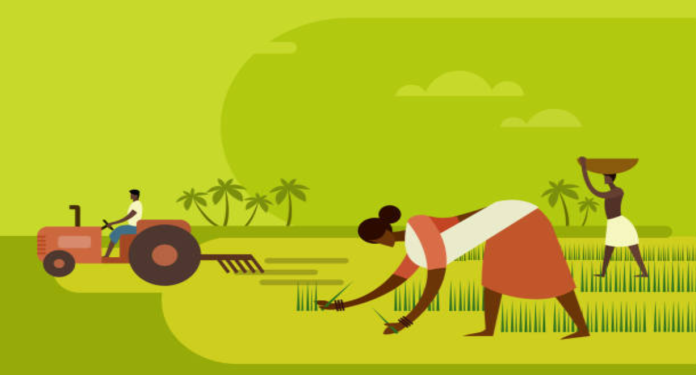India boasts an extensive history of agricultural practices, firmly establishing agriculture as a cornerstone of its economy. Over decades, this rich history of cultivation has showcased various types of farming practices across the country. These diverse practices have evolved and adapted to different regions and periods. They reflect the dynamic nature of agricultural techniques employed throughout India’s rural legacy.
Let’s explore these distinct farming practices, which have played pivotal roles in shaping India’s agricultural landscape alongside the Indo Farm Tractor Price.
Subsistence farming
In the realm of farming, it’s a shared responsibility where families collectively engage, with each member contributing in various capacities. Subsistence farming, a foundational and rudimentary form of agriculture in India, sees active participation from the entire household, dedicating themselves to farm labour.
Typically, these farms consist of small plots, and the farming activities are predominantly manual, relying on traditional techniques rather than embracing mechanised or modern methods prevalent in contemporary agriculture.
Consequently, the output or yield from these practices tends to be moderate, with a focus primarily on meeting the family’s consumption needs. The surplus produced is minimal, as the commercial aspect often takes a back seat, leaving only a limited excess for trade or sale.
Shifting Agriculture
Shifting agriculture, a prevalent farming method practised by tribal groups involves cultivating tuber and root crops. The process commences by clearing forested areas obtained by cutting down vegetation. Following this, new crops are planted in these areas.
This method’s defining characteristic is burning leftover produce or grass after cutting down trees. Seeds are then planted in the cleared ground, leading to the growth of staple crops like paddy, maise, and millet.
However, after a span of two to three years, the same plot is abandoned due to reduced yields caused by weed growth and soil fertility depletion. This necessitates the search for fresh land to repeat the cultivation process. Shifting agriculture, known by various names in different regions, notably involves minimal soil preparation or conventional farming practices like ploughing.
Shifting agriculture is known as ‘Jhum’ in Assam, ‘Podu’ in Andhra Pradesh, ‘Bera’ in various regions of Madhya Pradesh, and ‘Ponam’ in Kerala. It has led to multiple ecological repercussions in the areas where it’s practised.
Intensive Agriculture
This particular agricultural practice holds a prime position within the array of farming methods prevalent in India. As a consequence, there is a heightened utilisation of inputs, encompassing both capital and labour per unit of land area. Agriculture in this context is either partially or entirely mechanised, employing machinery such as threshers and harvesters for various farming activities.
The adoption of “high-yielding variety” seeds is a fundamental aspect of this approach, ensuring a surplus in production. Furthermore, extensive use of fertilisers and pesticides is made, emphasising the commercial aspects of farming produce over simple domestic consumption.
This contrasts starkly with the traditional farming method. Lower inputs per unit of land characterise it. This marks a departure from the extensive use of resources and machinery seen in modern agricultural practices.
Dryland Farming
Dry farming practices are prevalent in regions with limited irrigation facilities, challenging crops to withstand arid conditions. While some crops thrive with irrigation, their yield per hectare is generally lower in dry farming contexts. These regions often support only one crop annually due to these conditions.
States like Bihar, Rajasthan, Gujarat, and Madhya Pradesh frequently employ such agricultural methods, addressing challenges even as factors like Hindustan Tractor Price influence farming decisions.
Intercropping Agriculture
Intercropping, a farming method involving the simultaneous growth of two or more crops together, serves as a practical solution in densely populated regions facing challenges in acquiring arable land. This technique proves advantageous. It allows increased crop production within limited space. This addresses the prevalent land scarcity issue in such areas.
The utilisation of intercropping optimises resources like land, fertile soil, fertilisers, and irrigation, making efficient use of these resources that might otherwise remain underutilised when dedicated to a single crop. The selection of crops with different nutrient needs reduces resource competition among planted species. This approach enhances overall productivity without requiring more space.
Conclusion
However, to maintain productivity, it’s crucial to prevent competition among crops for space, nutrients, water, and sunlight. Farmers must carefully manage the coexistence of crops to avoid any impediment to their growth caused by competition for essential resources.
Additionally, intercropping finds synergy with mixed farming, where agricultural cultivation combines with livestock rearing, known as Mixed Farming. This integrated approach, encompassing both crop cultivation and animal husbandry, contributes to a diversified and sustainable farming system. Meanwhile, considering the Mrf Tractor Tyre Price, in this context, emphasises the affordability and viability of such agricultural practices.








